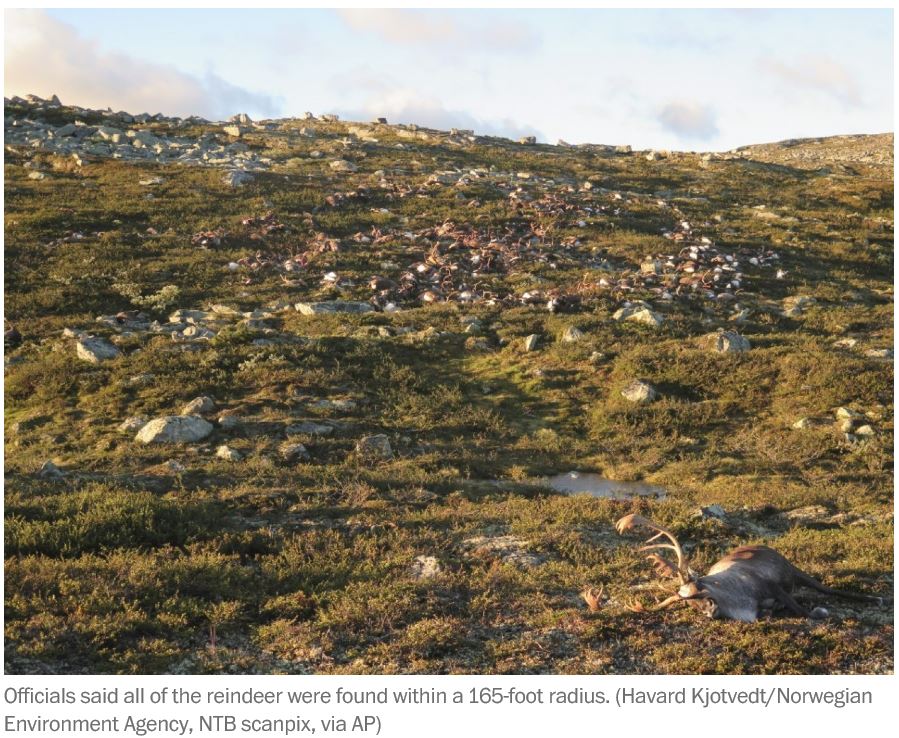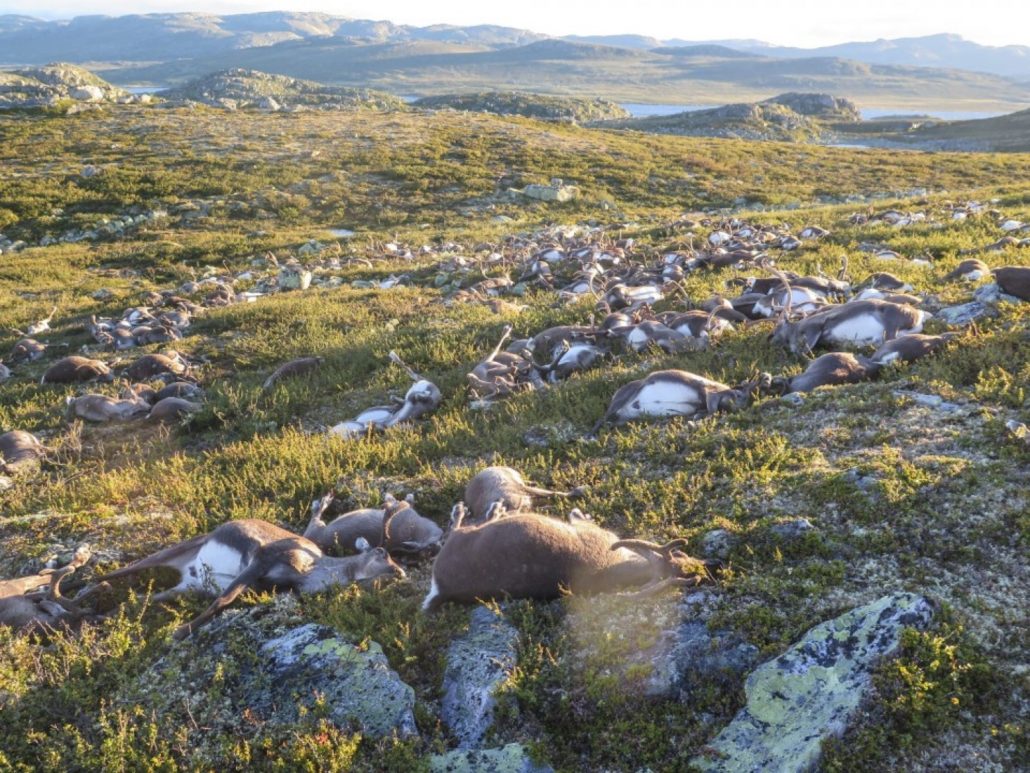
Nature is a serious lady. This is a bummer of a story, but it shows the power that Mother Nature harnesses with respect to light, in this case in the form of lightning.

Last Friday (26 August 2016) in a large thunderstorm system in a private game reserve in Norway, an estimated 323 reindeer were killed in a lightning strike. From WaPo reporter Karin Brulliard on the story:
The 323 reindeer were killed by lightning Friday, the agency said, in a rare natural massacre that counts as the deadliest lightning strike on record. It took place in a private hunting area of the Hardangervidda mountain plateau in central southern Norway, a verdant and frigid tableau of streams, rocks and glaciers that is home to one of the largest reindeer herds in Europe.
Officials told Agence France-Presse that a gamekeeper stumbled upon the eerie scene Friday and that 70 young reindeer were among the victims. Five animals had to be euthanized, said officials, who told the news service that they were not sure what they would do with the bodies. The gamekeeper told NTB, the Norwegian news service, that samples of the carcasses were sent to a state veterinary institute, which would officially determine the cause of death.
“We’ve never seen anything like this on this scale,” agency official Kjartan Knutsen said.” There were very strong storms in the area on Friday. The animals stay close together in bad weather and these ones were hit by lightning.”
There is some flyover video of the scene — it’s not gruesome or bloody or anything, but please know it’s ghastly:
Nature, you are a cruel mistress sometimes, huh.
Angela Chen, science writer for The Verge, et al, interviewed John Jensenius at NOAA to talk about the phenomenon of mass animal deaths attributed to lightning strikes like this. Angela, this was a great read! Y’all need to check out her writing!
Angela Chen:
First, how likely is it that it really was lightning that killed those reindeer? Is there a way to know without having seen the strike directly?
John Jensenius:
It isn’t that unusual to see farm animals, or wild animals such as reindeer, being killed by lightning. Of course, 323 is a rather large number, though we’ve seen reports of 654 sheep being killed in one spot.
Animals do tend to group together in storms and huddle under trees. If lightning strikes the tree or somewhere nearby, the entire group can be killed. We don’t know how common this is because it’s hard to track, though usually it’s herds of 10 or 20 animals that get killed.
In the case where the animals are huddling under a tree, oftentimes you’ll see some visible signs on the tree, though you may not see any visible signs on the animals themselves. In this case, it’s hard to know where lightning struck based on the pictures, but there may be an animal among the dead animals that has visible signs, like a bit of charring on the skin.
Angela Chen:
How did lightning kill all of those reindeer at once? Did they need to be touching for this to happen?
John Jensenius:
When animals or people are in groups, most are being killed by the ground current. First, there’s a direct strike – this is what most people think of when they think of lightning – that hits the tree or maybe the ground nearby. The energy then spreads along the ground surface, and if you’re anywhere near that lightning strike, you absorb it and get shocked.
Lightning goes up one leg and down another. Animals are more vulnerable because their legs are spread out more, so the ground currents travel more easily in their bodies. It doesn’t matter if they’re touching, or exactly how close they are, it matters that they were all in the area hit by lightning. Ground currents are the thing that’s responsible for the most lightning deaths and injuries in both people and animals.
Angela Chen:
How far can the ground current travel? When are you safe?
John Jensenius:
That’s one question we’re often asked, and it’s a difficult question because it depends on a lot of factors, including the strength of the actual lightning strike.
In this case, the animals seem to be in an area that was 50 to 80 feet in diameter and on a hillside, which gives you some idea that lightning can travel a good distance and still be deadly. Lightning doesn’t always travel deep into the ground.

Angela Chen:
What exactly is it about lightning that kills these animals?
John Jensenius:
It’s the electricity going into your body. It passes through the nervous system and your nerves, and the deadly part is that it stops the heart. In the case of people, many can be revived with CPR if tended to immediately but with reindeer, it just would have stopped their hearts.
Angela Chen:
What are some other types of lightning besides the ground current and the direct strike?
John Jensenius:
There’s the side flash. That’s when an animal or person is standing close to the tree, the tree is hit by lightning, and then the lightning jumps from tree to person or animal. The side flash usually kills one or a small number of animals, not large ones like with ground currents.
There’s also something called a “wall conduction,” which is when something plugged into the wall is a direct connection to a wire outside. So if the wire outside is struck, the lightning will follow the wire and you can be shocked.
Angela Chen:
Are lightning fatalities, in people at least, going down?
John Jensenius:
Yes, they’ve been dropping over recent years. If you go back over the 1930s and 1940s, we had about 300 to 400 people killed every year in the United States. Nowadays, our 10-year average is about 31 people per year. This year so far we’ve had 32.

Research and hat tips:
Angela Chen, of course! https://twitter.com/chengela
http://www.theverge.com/users/angelachen
http://www.theverge.com/2016/8/29/12690402/lightning-strike-kills-norway-reindeer-death-why-science
http://wric.com/2016/08/29/lightning-strike-kills-more-than-300-reindeer-during-one-storm/
http://www.bbc.com/news/world-europe-37214288
http://www.sciencealert.com/a-lightning-strike-just-killed-300-reindeer-in-norway
https://www.yahoo.com/news/more-300-reindeer-killed-lightning-norway-095020805.html




